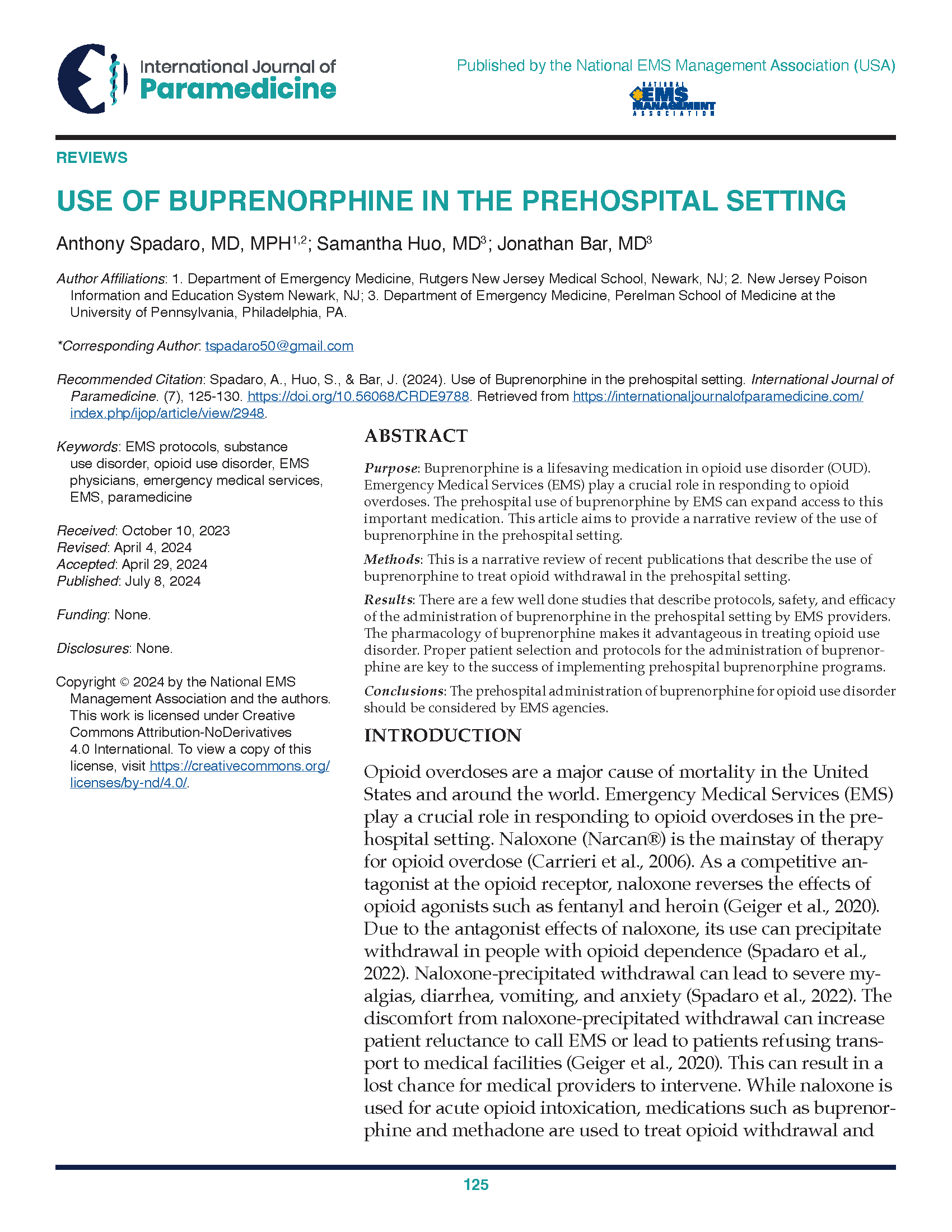Use of Buprenorphine in the Prehospital Setting
Main Article Content
Abstract
Purpose: Buprenorphine is a lifesaving medication in opioid use disorder (OUD). Emergency Medical Services (EMS) play a crucial role in responding to opioid overdoses. The pre-hospital use of buprenorphine by EMS can expand access to this important medication. This article aims to provide a narrative review of the use of buprenorphine in the pre-hospital setting.
Methods: This is a narrative review of recent publications that describe the use of buprenorphine to treat opioid withdrawal in the pre-hospital setting.
Results: There are a few well done studies that describe protocols, safety, and efficacy of the administration of buprenorphine in the pre-hospital setting by EMS providers. The pharmacology of buprenorphine makes it advantageous in treating opioid use disorder. Proper patient selection and protocols for the administration of buprenorphine are key to the success of implementing pre-hospital buprenorphine programs.
Conclusions: The pre-hospital administration of buprenorphine for opioid use disorder should be considered by EMS agencies.
Article Details

This work is licensed under a Creative Commons Attribution-NoDerivatives 4.0 International License.
Publishing in IJOP allows authors to keep their copyright while giving IJOP unrestricted copyright permissions. Articles published in IJOP use Creative Common Attribution 4.0 International (CC BY-ND 4.0) licensing. This license requires that re-users give credit to the creator. It allows re-users to copy and distribute the material in any medium or format in unadapted form only, even for commercial purposes. Additional terms apply and can be accessed here.
Publishing in IJOP also allows authors to have contracts for non-exclusive distribution of the Journal's published version of the article, such as posting to an institutional repository or publication in a book, on the condition that the original publication in the original layout format in IJOP is retained and acknowledged.
We permit and encourage authors to post the articles they published in IJOP on their affiliated websites. This helps share the information, encourages citation in other works, and promotes scholarly discourse in the spirit of open access.
References
Carrieri, M. P., Amass, L., Lucas, G. M., Vlahov, D., Wodak, A., & Woody, G. E. (2006). Buprenorphine use: the international experience. Clinical infectious diseases : an official publication of the Infectious Diseases Society of America, 43 Suppl 4, S197–S215. https://doi.org/10.1086/508184
Carroll, G. G., Wasserman, D. D., Shah, A. A., Salzman, M. S., Baston, K. E., Rohrbach, R. A., Jones, I. L., & Haroz, R. (2021). Buprenorphine field initiation of ReScue treatment by emergency medical services (Bupe FIRST EMS): a case series. Prehospital Emergency Care, 25(2), 289–293. https://doi.org/10.1080/10903127.2020.1747579
Carroll, G., Solomon, K. T., Heil, J., Saloner, B., Stuart, E. A., Patel, E. Y., Greifer, N., Salzman, M., Murphy, E., Baston, K., & Haroz, R. (2022). Impact of administering buprenorphine to overdose survivors using emergency nedical services. Annals of Emergency Medicine. https://doi.org/10.1016/j.annemergmed.2022.07.006
Davis, C. S., Carr, D. H., Glenn, M. J., & Samuels, E. A. (2021). Legal authority for emergency medical services to increase access to buprenorphine treatment for opioid use disorder. Annals of Emergency Medicine, 78(1), 102–108. https://doi.org/10.1016/j.annemergmed.2021.01.017
Geiger, C., Smart, R., & Stein, B. D. (2020). Who receives naloxone from emergency medical services? Characteristics of calls and recent trends. Substance Abuse, 41(3), 400–407. https://doi.org/10.1080/08897077.2019.1640832
Hern, H. G., Goldstein, D., Kalmin, M., Kidane, S., Shoptaw, S., Tzvieli, O., & Herring, A. A. (2022a). Prehospital initiation of buprenorphine treatment for opioid use disorder by paramedics. Prehospital Emergency Care, 26(6), 811–817. https://doi.org/10.1080/10903127.2021.1977440
Hern, H. G., Lara, V., Goldstein, D., Kalmin, M., Kidane, S., Shoptaw, S., Tzvieli, O., & Herring, A. A. (2022b). Prehospital buprenorphine treatment for opioid use disorder by paramedics: First year results of the EMS buprenorphine use pilot. Prehospital Emergency Care. https://doi.org/10.1080/10903127.2022.2061661
Herring, A. A., Perrone, J., & Nelson, L. S. (2019). Managing opioid withdrawal in the emergency department with buprenorphine. In Annals of Emergency Medicine (Vol. 73, Issue 5, pp. 481–487). Mosby Inc. https://doi.org/10.1016/j.annemergmed.2018.11.032
Linas, B., & Linas, B. (2023, February 14). The X-waiver for buprenorphine prescribing is gone. It’s time to spread the word. Https://www.statnews.com/2023/02/14/x-Waiver-Buprenorphine-Prescribing-Gone-Spread-the-Word/.
Substance Abuse and Mental Health Services Administraiton. (n.d.). Buprenorphine quick start guide. https://www.findtreatment.samhsa.gov
Spadaro, A., Long, B., Koyfman, A., & Perrone, J. (2022). Buprenorphine precipitated opioid withdrawal: Prevention and management in the ED setting. The American Journal of Emergency Medicine, 58, 22–26. https://doi.org/10.1016/j.ajem.2022.05.013
Wakeman, J. (2022, April 25). Community paramedics introduce medication-assisted treatment for opioid use. Https://mountainx.com/Living/Medication-Assisted-Treatment-Buncombe-County/
Winkler, J. (2023, March). To stem a rising tide of fentanyl overdoses, these Texas paramedics are going door-to-door. https://www.texasmonthly.com/News-Politics/Fentanyl-Opioid-Overdoses-Paramedics-Harm-Reduction/

